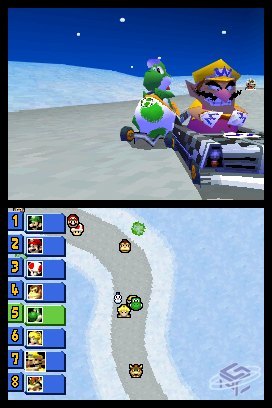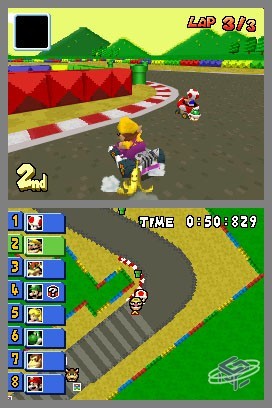Is this both the definitive DS title and the best Mario Kart game EVER?
Name: Mario Kart DS
System: DS
Year: 2005
Innovations: Two screen gameplay, true online play, mission mode
The GameCube release, Double Dash, did receive its fair share of glowing reviews, but part of the fanbase was still left cold by the risks it decided to take. A year after the game was released, Nintendo presented for the first time the Nintendo DS. The system was unique, thanks to two screens, one of them a touch screen. The handheld also featured a microphone and, most important of all, Wi-Fi capabilities. The laundry list of features alone made the DS a grand curiosity among many, even if its launch is considered to this day one of the weakest in Nintendo history. The first batch of games were good enough, and the way they use the DS's capabilities were captivating, but for nearly a year the system lacked that one game that would inspire players to invest in the handheld. Luckily, the fall of 2005 saw the games people were heavily clamoring for, and one of these happened to be none other than Mario Kart DS.
Mario Kart DS brought the series back to its roots. It retained the character-themed karts made famous in Double Dash but dropped the second driver. Racing for the most part remained straightforward, and that was enough for a lot of fans. Where the game really shined, though, was in its content. Its additional features were standard in the genre, but were so polished it added to the whole experience. One of these happened to be a mission mode where players could complete challenges, many of them in unique arenas and featuring characters not seen in the regular game.

The DS was a handheld that easily lent itself to both practical and gimmicky gameplay ideas. Before Mario Kart Ds was released, the hardware was used on games that were all about gimmicks but not about practical gameplay ideas. Mario Kart DS took its innovations and used it in a manner that was both sound on paper an in execution. There was no need to rely on the touch screen. Instead, the game used it as a second map, reminiscent of Super Mario Kart on the Super NES. Players would be able to see incoming opponents as well as items that were littering the track.
Even the wireless features were used to great effect in Mario Kart DS. Whereas Mario Kart: Super Circuit was held back in terms of multiplayer on a handheld, Mario Kart DS went all out. Players could connect wirelessly to other DS systems, eliminating completely the need for link cables. Much like in Super Circuit, those that didn't have the cartridge could still participate using Download Play, but the bulk of the game would be unlocked once all players had a cartridge. The scope of participating players was also doubled, now with up to eight players connecting wirelessly.

If the expanded local features weren't enough for players, Mario Kart DS made history by being the first in the series to feature real online play. Using Nintendo's free Wi-Fi connection service, players itching to prove their kart racing skills online finally saw their dream become a reality. All the features seen in the regular game could be played online with up to eight other players. This dream also came with the Friend Code system. The Friend Code was Nintendo's method of online security. Each game would have a unique code that players would need to trade and input if they ever wanted to participate online. The system was ill-received right out of the game, forcing players to input many codes just to have a full online friend roster. The Friend Codes would remain an important feature for other Nintendo online games on the DS and also the Wii. Regardless, millions of players quickly embraced the online aspect of the game, building a subculture of fans that would exchange tricks and tips as well as shortcuts and various other strategies.

The best way to fully explain Mario Kart DS is that it is a nice mix of the old and the new. The gameplay didn't feature any new groundbreaking ideas, but it all worked so well that players didn't need gimmicks for the game to have everlasting appeal. Its innovations lay mainly in existing ideas that were further expanded upon, the online mode being a fine example. It took nearly ten years of innovations and put it all in one package players kept coming back to time and time again.

